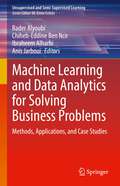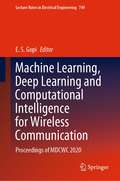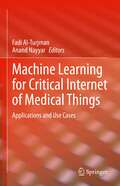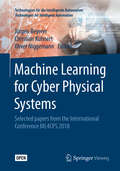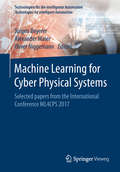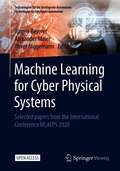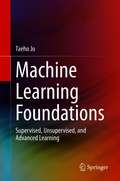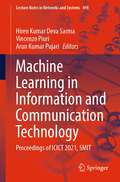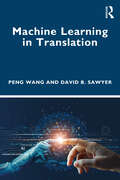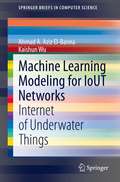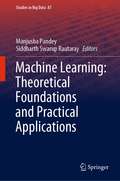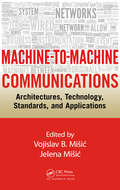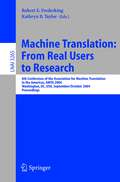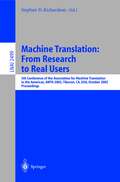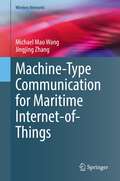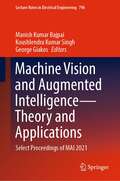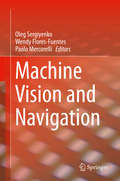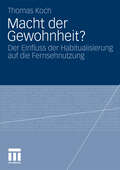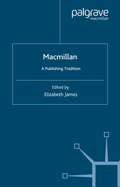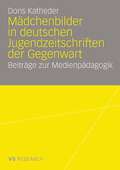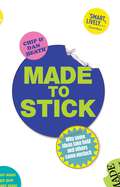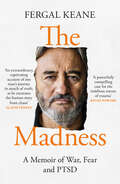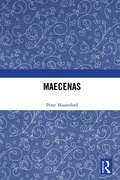- Table View
- List View
Machine Learning and Data Analytics for Solving Business Problems: Methods, Applications, and Case Studies (Unsupervised and Semi-Supervised Learning)
by Bader Alyoubi Chiheb-Eddine Ben Ncir Ibraheem Alharbi Anis JarbouiThis book presents advances in business computing and data analytics by discussing recent and innovative machine learning methods that have been designed to support decision-making processes. These methods form the theoretical foundations of intelligent management systems, which allows for companies to understand the market environment, to improve the analysis of customer needs, to propose creative personalization of contents, and to design more effective business strategies, products, and services. This book gives an overview of recent methods – such as blockchain, big data, artificial intelligence, and cloud computing – so readers can rapidly explore them and their applications to solve common business challenges. The book aims to empower readers to leverage and develop creative supervised and unsupervised methods to solve business decision-making problems.
Machine Learning, Deep Learning and Computational Intelligence for Wireless Communication: Proceedings of MDCWC 2020 (Lecture Notes in Electrical Engineering #749)
by E. S. GopiThis book is a collection of best selected research papers presented at the Conference on Machine Learning, Deep Learning and Computational Intelligence for Wireless Communication (MDCWC 2020) held during October 22nd to 24th 2020, at the Department of Electronics and Communication Engineering, National Institute of Technology Tiruchirappalli, India. The presented papers are grouped under the following topics (a) Machine Learning, Deep learning and Computational intelligence algorithms (b)Wireless communication systems and (c) Mobile data applications and are included in the book. The topics include the latest research and results in the areas of network prediction, traffic classification, call detail record mining, mobile health care, mobile pattern recognition, natural language processing, automatic speech processing, mobility analysis, indoor localization, wireless sensor networks (WSN), energy minimization, routing, scheduling, resource allocation, multiple access, power control, malware detection, cyber security, flooding attacks detection, mobile apps sniffing, MIMO detection, signal detection in MIMO-OFDM, modulation recognition, channel estimation, MIMO nonlinear equalization, super-resolution channel and direction-of-arrival estimation. The book is a rich reference material for academia and industry.
Machine Learning for Critical Internet of Medical Things: Applications and Use Cases
by Fadi Al-Turjman Anand NayyarThis book discusses the applications, challenges, and future trends of machine learning in medical domain, including both basic and advanced topics. The book presents how machine learning is helpful in smooth conduction of administrative processes in hospitals, in treating infectious diseases, and in personalized medical treatments. The authors show how machine learning can also help make fast and more accurate disease diagnoses, easily identify patients, help in new types of therapies or treatments, model small-molecule drugs in pharmaceutical sector, and help with innovations via integrated technologies such as artificial intelligence as well as deep learning. The authors show how machine learning also improves the physician’s and doctor’s medical capabilities to better diagnosis their patients. This book illustrates advanced, innovative techniques, frameworks, concepts, and methodologies of machine learning that will enhance the efficiency and effectiveness of the healthcare system.Provides researchers in machine and deep learning with a conceptual understanding of various methodologies of implementing the technologies in medical areas;Discusses the role machine learning and IoT play into locating different virus and diseases across the globe, such as COVID-19, Ebola, and cervical cancer;Includes fundamentals and advances in machine learning in the medical field, supported by significant case studies and practical applications.
Machine Learning for Cyber Physical Systems
by Jürgen Beyerer Christian Kühnert Oliver NiggemannThis Open Access proceedings presents new approaches to Machine Learning for Cyber Physical Systems, experiences and visions. It contains some selected papers from the international Conference ML4CPS – Machine Learning for Cyber Physical Systems, which was held in Karlsruhe, October 23-24, 2018. Cyber Physical Systems are characterized by their ability to adapt and to learn: They analyze their environment and, based on observations, they learn patterns, correlations and predictive models. Typical applications are condition monitoring, predictive maintenance, image processing and diagnosis. Machine Learning is the key technology for these developments.
Machine Learning for Cyber Physical Systems: Selected papers from the International Conference ML4CPS 2017 (Technologien für die intelligente Automation #11)
by Jürgen Beyerer Alexander Maier Oliver NiggemannThe work presents new approaches to Machine Learning for Cyber Physical Systems, experiences and visions. It contains some selected papers from the international Conference ML4CPS – Machine Learning for Cyber Physical Systems, which was held in Lemgo, October 25th-26th, 2017. Cyber Physical Systems are characterized by their ability to adapt and to learn: They analyze their environment and, based on observations, they learn patterns, correlations and predictive models. Typical applications are condition monitoring, predictive maintenance, image processing and diagnosis. Machine Learning is the key technology for these developments.
Machine Learning for Cyber Physical Systems: Selected papers from the International Conference ML4CPS 2020 (Technologien für die intelligente Automation #13)
This open access proceedings presents new approaches to Machine Learning for Cyber Physical Systems, experiences and visions. It contains selected papers from the fifth international Conference ML4CPS – Machine Learning for Cyber Physical Systems, which was held in Berlin, March 12-13, 2020. Cyber Physical Systems are characterized by their ability to adapt and to learn: They analyze their environment and, based on observations, they learn patterns, correlations and predictive models. Typical applications are condition monitoring, predictive maintenance, image processing and diagnosis. Machine Learning is the key technology for these developments.
Machine Learning Foundations: Supervised, Unsupervised, and Advanced Learning
by Taeho JoThis book provides conceptual understanding of machine learning algorithms though supervised, unsupervised, and advanced learning techniques. The book consists of four parts: foundation, supervised learning, unsupervised learning, and advanced learning. The first part provides the fundamental materials, background, and simple machine learning algorithms, as the preparation for studying machine learning algorithms. The second and the third parts provide understanding of the supervised learning algorithms and the unsupervised learning algorithms as the core parts. The last part provides advanced machine learning algorithms: ensemble learning, semi-supervised learning, temporal learning, and reinforced learning.Provides comprehensive coverage of both learning algorithms: supervised and unsupervised learning;Outlines the computation paradigm for solving classification, regression, and clustering;Features essential techniques for building the a new generation of machine learning.
Machine Learning in Information and Communication Technology: Proceedings of ICICT 2021, SMIT (Lecture Notes in Networks and Systems #498)
by Hiren Kumar Deva Sarma Vincenzo Piuri Arun Kumar PujariThis book presents collection of research papers presented at International Conference on Information and Communication Technology (ICICT 2021) organized by Department of Information Technology, Sikkim Manipal Institute of Technology, Sikkim, India, during 23–24 December 2021. The book includes papers in the research area of communication networks, data science, healthcare informatics, bio-medical image processing, security of information including cryptography, machine learning applications, and AI applications.
Machine Learning in Translation
by Peng Wang David B. SawyerMachine Learning in Translation introduces machine learning (ML) theories and technologies that are most relevant to translation processes, approaching the topic from a human perspective and emphasizing that ML and ML-driven technologies are tools for humans. Providing an exploration of the common ground between human and machine learning and of the nature of translation that leverages this new dimension, this book helps linguists, translators, and localizers better find their added value in a ML-driven translation environment. Part One explores how humans and machines approach the problem of translation in their own particular ways, in terms of word embeddings, chunking of larger meaning units, and prediction in translation based upon the broader context. Part Two introduces key tasks, including machine translation, translation quality assessment and quality estimation, and other Natural Language Processing (NLP) tasks in translation. Part Three focuses on the role of data in both human and machine learning processes. It proposes that a translator’s unique value lies in the capability to create, manage, and leverage language data in different ML tasks in the translation process. It outlines new knowledge and skills that need to be incorporated into traditional translation education in the machine learning era. The book concludes with a discussion of human-centered machine learning in translation, stressing the need to empower translators with ML knowledge, through communication with ML users, developers, and programmers, and with opportunities for continuous learning. This accessible guide is designed for current and future users of ML technologies in localization workflows, including students on courses in translation and localization, language technology, and related areas. It supports the professional development of translation practitioners, so that they can fully utilize ML technologies and design their own human-centered ML-driven translation workflows and NLP tasks.
Machine Learning in Translation
by Peng Wang David B. SawyerMachine Learning in Translation introduces machine learning (ML) theories and technologies that are most relevant to translation processes, approaching the topic from a human perspective and emphasizing that ML and ML-driven technologies are tools for humans. Providing an exploration of the common ground between human and machine learning and of the nature of translation that leverages this new dimension, this book helps linguists, translators, and localizers better find their added value in a ML-driven translation environment. Part One explores how humans and machines approach the problem of translation in their own particular ways, in terms of word embeddings, chunking of larger meaning units, and prediction in translation based upon the broader context. Part Two introduces key tasks, including machine translation, translation quality assessment and quality estimation, and other Natural Language Processing (NLP) tasks in translation. Part Three focuses on the role of data in both human and machine learning processes. It proposes that a translator’s unique value lies in the capability to create, manage, and leverage language data in different ML tasks in the translation process. It outlines new knowledge and skills that need to be incorporated into traditional translation education in the machine learning era. The book concludes with a discussion of human-centered machine learning in translation, stressing the need to empower translators with ML knowledge, through communication with ML users, developers, and programmers, and with opportunities for continuous learning. This accessible guide is designed for current and future users of ML technologies in localization workflows, including students on courses in translation and localization, language technology, and related areas. It supports the professional development of translation practitioners, so that they can fully utilize ML technologies and design their own human-centered ML-driven translation workflows and NLP tasks.
Machine Learning Modeling for IoUT Networks: Internet of Underwater Things (SpringerBriefs in Computer Science)
by Ahmad A. Aziz El-Banna Kaishun WuThis book discusses how machine learning and the Internet of Things (IoT) are playing a part in smart control of underwater environments, known as Internet of Underwater Things (IoUT). The authors first present seawater’s key physical variables and go on to discuss opportunistic transmission, localization and positioning, machine learning modeling for underwater communication, and ongoing challenges in the field. In addition, the authors present applications of machine learning techniques for opportunistic communication and underwater localization. They also discuss the current challenges of machine learning modeling of underwater communication from two communication engineering and data science perspectives.
Machine Learning: Theoretical Foundations and Practical Applications (Studies in Big Data #87)
by Manjusha Pandey Siddharth Swarup RautarayThis edited book is a collection of chapters invited and presented by experts at 10th industry symposium held during 9–12 January 2020 in conjunction with 16th edition of ICDCIT. The book covers topics, like machine learning and its applications, statistical learning, neural network learning, knowledge acquisition and learning, knowledge intensive learning, machine learning and information retrieval, machine learning for web navigation and mining, learning through mobile data mining, text and multimedia mining through machine learning, distributed and parallel learning algorithms and applications, feature extraction and classification, theories and models for plausible reasoning, computational learning theory, cognitive modelling and hybrid learning algorithms.
Machine-to-Machine Communications: Architectures, Technology, Standards, and Applications
by Vojislav B. Misic Jelena MisicWith the number of machine-to-machine (M2M)-enabled devices projected to reach 20 to 50 billion by 2020, there is a critical need to understand the demands imposed by such systems. Machine-to-Machine Communications: Architectures, Technology, Standards, and Applications offers rigorous treatment of the many facets of M2M communication, including it
Machine Translation: 6th Conference of the Association for Machine Translation in the Americas, AMTA 2004, Washington, DC, USA, September 28-October 2, 2004, Proceedings (Lecture Notes in Computer Science #3265)
by Robert E. Frederking Kathryn B. TaylorThe previous conference in this series (AMTA 2002) took up the theme “From Research to Real Users”, and sought to explore why recent research on data-driven machine translation didn’t seem to be moving to the marketplace. As it turned out, the ?rst commercial products of the data-driven research movement were just over the horizon, andintheinterveningtwoyearstheyhavebeguntoappearinthemarketplace. Atthesame time,rule-basedmachinetranslationsystemsareintroducingdata-driventechniquesinto the mix in their products. Machine translation as a software application has a 50-year history. There are an increasing number of exciting deployments of MT, many of which will be exhibited and discussed at the conference. But the scale of commercial use has never approached the estimates of the latent demand. In light of this, we reversed the question from AMTA 2002, to look at the next step in the path to commercial success for MT. We took user needs as our theme, and explored how or whether market requirements are feeding into research programs. The transition of research discoveries to practical use involves te- nicalquestionsthatarenotassexyasthosethathavedriventheresearchcommunityand research funding. Important product issues such as system customizability, computing resource requirements, and usability and ?tness for particular tasks need to engage the creativeenergiesofallpartsofourcommunity,especiallyresearch,aswemovemachine translation from a niche application to a more pervasive language conversion process. Thesetopicswereaddressedattheconferencethroughthepaperscontainedinthesep- ceedings, and even more speci?cally through several invited presentations and panels.
Machine Translation: 5th Conference of the Association for Machine Translation in the Americas, AMTA 2002 Tiburon, CA, USA, October 6-12, 2002. Proceedings (Lecture Notes in Computer Science #2499)
by Stephen D. RichardsonAMTA 2002: From Research to Real Users Ever since the showdown between Empiricists and Rationalists a decade ago at TMI 92, MT researchers have hotly pursued promising paradigms for MT, including da- driven approaches (e.g., statistical, example-based) and hybrids that integrate these with more traditional rule-based components. During the same period, commercial MT systems with standard transfer archit- tures have evolved along a parallel and almost unrelated track, increasing their cov- age (primarily through manual update of their lexicons, we assume) and achieving much broader acceptance and usage, principally through the medium of the Internet. Webpage translators have become commonplace; a number of online translation s- vices have appeared, including in their offerings both raw and postedited MT; and large corporations have been turning increasingly to MT to address the exigencies of global communication. Still, the output of the transfer-based systems employed in this expansion represents but a small drop in the ever-growing translation marketplace bucket.
Machine-Type Communication for Maritime Internet-of-Things: From Concept to Practice (Wireless Networks)
by Michael Mao Wang Jingjing ZhangThis book introduces the concept of machine-type communication (MTC) for maritime Internet of Things. The first part of the book portrays a maritime MTC system from an architectural perspective and describes an MTC framework and the fundamental components, laying out a foundation that leads to an ultimate solution to the maritime IoT requirements and challenges. The second part ties together all discussed in the first part and demonstrates how to apply it to a practical system through a realistic design example based on an international maritime mobile spectrum. The book serves as a comprehensive tutorial of the maritime MTC from the top (the network architecture) to the bottom (the air/radio interface and regulatory radio spectrum constraints), guiding readers to an easier understanding of the maritime MTC-related issues and the rationale behind the design. The primary readers of this book include maritime communication engineers, maritime IoT professionals, maritime academia, and the general MTC and IoT communities.Presents the concept of machine-type communication (MTC) for maritime Internet of Things (IoT) and its services, requirements, and challenges;Explains space-earth-integrated maritime machine-type communication system architecture with a comparison with its land counterpart;Sets out a comprehensive framework and details the ways to implement it on a practical radio spectrum;Includes maritime MTC radio spectrum and regulations, network design, protocol design, and air interface design.
Machine Vision and Augmented Intelligence—Theory and Applications: Select Proceedings of MAI 2021 (Lecture Notes in Electrical Engineering #796)
by Manish Kumar Bajpai Koushlendra Kumar Singh George GiakosThis book comprises the proceedings of the International Conference on Machine Vision and Augmented Intelligence (MAI 2021) held at IIIT, Jabalpur, in February 2021. The conference proceedings encapsulate the best deliberations held during the conference. The diversity of participants in the event from academia, industry, and research reflects in the articles appearing in the volume. The book theme encompasses all industrial and non-industrial applications in which a combination of hardware and software provides operational guidance to devices in the execution of their functions based on the capture and processing of images. This book covers a wide range of topics such as modeling of disease transformation, epidemic forecast, COVID-19, image processing and computer vision, augmented intelligence, soft computing, deep learning, image reconstruction, artificial intelligence in healthcare, brain-computer interface, cybersecurity, and social network analysis, natural language processing, etc.
Machine Vision and Navigation
by Oleg Sergiyenko Wendy Flores-Fuentes Paolo MercorelliThis book presents a variety of perspectives on vision-based applications. These contributions are focused on optoelectronic sensors, 3D & 2D machine vision technologies, robot navigation, control schemes, motion controllers, intelligent algorithms and vision systems. The authors focus on applications of unmanned aerial vehicles, autonomous and mobile robots, industrial inspection applications and structural health monitoring. Recent advanced research in measurement and others areas where 3D & 2D machine vision and machine control play an important role, as well as surveys and reviews about vision-based applications. These topics are of interest to readers from diverse areas, including electrical, electronics and computer engineering, technologists, students and non-specialist readers.• Presents current research in image and signal sensors, methods, and 3D & 2D technologies in vision-based theories and applications; • Discusses applications such as daily use devices including robotics, detection, tracking and stereoscopic vision systems, pose estimation, avoidance of objects, control and data exchange for navigation, and aerial imagery processing; • Includes research contributions in scientific, industrial, and civil applications.
Macmillan: A Publishing Tradition, 1843-1970
by E. JamesFor over one hundred and fifty years, since its founding in 1843, Macmillan has been at the heart of British publishing. This collection of essays, representing recent research in the archives at the British library, examines the firms' astute business strategy during the nineteenth century, its successful expansion into overseas markets in America and India, its complex and intriguing relations with authors such as Matthew Arnold, Thomas Hardy, Alfred Lord Tennyson, W.B.Yeats, and J.M.Keynes, with additional chapters on Macmillan Magazine and the work of a modern children's editor.
Madame Depardieu and the Beautiful Strangers
by Antonia QuirkeA razor-sharp and achingly funny memoir of the men and movies that shaped one woman’s life…
Mädchenbilder in deutschen Jugendzeitschriften der Gegenwart: Beiträge zur Medienpädagogik
by Doris KathederDoris Katheder untersucht Mädchenbilder als kulturell-symbolische Interpretationen von kommerziellen deutschen Mädchen- und Jugendzeitschriften und kontrastiert sie mit exemplarisch ausgewählten nicht-kommerziellen Zeitschriften. Sie zeigt, dass nicht-kommerzielle Jugendmedien das kritische Bewusstsein der Leserin zu schärfen und Mädchenbilder als realistische Weltbilder zu zeichnen versuchen.
Made to Stick: Why some ideas take hold and others come unstuck
by Chip Heath Dan HeathWhy does fake news stick while the truth goes missing?Why do disproved urban legends persist? How do you keep letting newspapers and clickbait sites lure you in with their headlines? And why do you remember complicated stories but not complicated facts?Over ten years of study, Chip and Dan Heath have discovered how we latch on to information hooks. Packed full of case histories and incredible anecdotes, it shows:- how an Australian scientist convinced the world he'd discovered the cause of stomach ulcers by drinking a glass filled with bacteria- how a gifted sports reporter got people to watch a football match by showing them the outside of the stadium- how pitches like 'Jaws on a spaceship' (Alien) and 'Die Hard on a bus' (Speed) convince movie execs to invest gigantic sums even when they know nothing else about the projectAs entertaining as it is informative, this is a timely exploration of a fascinating human behaviour. At the same time, by demonstrating strategies like the 'Velcro Theory of Memory' and 'curiosity gaps', it offers superbly practical insights.Made to Stick uses cutting-edge insight to help you ensure that what you say is understood, remembered and, most importantly, acted upon.
Maecenas
by Peter MountfordWhile much has been written of the importance of Agrippa in Augustus’ rise to power as the first emperor of Rome, Maecenas remains a shadowy figure despite being a vital part in the success of Augustus. After the assassination of Julius Caesar, Maecenas was a vital negotiator between Octavian and Mark Antony in the years leading up to the battle of Actium, and a wise political advisor to Augustus during the early years of the new regime. This is the first biography of Maecenas in English and gives due credit to the stature of Maecenas both as a confidant of the emperor and as patron of the poets Virgil, Horace and Propertius. The book devotes a chapter to each poet’s relationship with Maecenas and the Augustan regime: the chapter on Virgil, while considering his relationship to Maecenas and Augustus, argues that the origins of his choice of Aeneas may lie in Etruria rather than elsewhere, while the chapter on Horace assesses one of the closest documented relationships of Roman history. The chapter on Propertius wrestles with the disparate views of scholars on the question of his relationship with the Augustan regime and argues that, at heart, he remains an Umbrian/Etruscan rather than a Roman. A crucial feature of the book is the provision of 161 texts from ancient Roman and Greek authors which mention Maecenas. Based on sustainable evidence this study of the importance of Maecenas takes scholarship in new and important directions.
